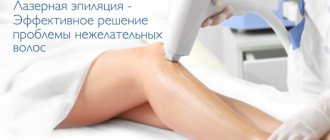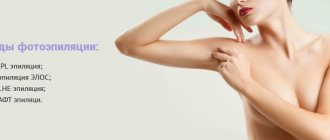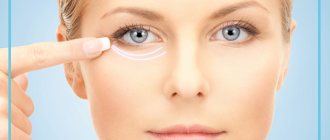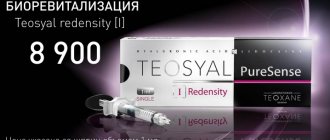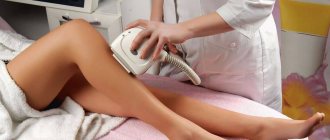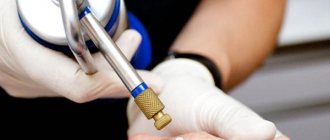Photoepilation is one of the safest, most effective and painless methods of hair removal. The popularity of this method is steadily growing every year. With the help of photoepilation, you can permanently remove hair from any part of the face and body, get rid of the problem of ingrown hairs and constant irritation after shaving.
The most popular are photoepilation of the deep bikini area (intimate photoepilation) and photoepilation of the armpits, which allow you to remove unwanted hair and feel confident in any situation.
How is the photoepilation procedure performed?
The procedure is shown in the following photographs:
Before the session begins, the doctor clarifies all indications and explains contraindications for the procedure, determines the necessary parameters of the procedure depending on the skin phototype, hair color and thickness. For maximum effectiveness of the photoepilation procedure, the hair length should be no more than 1-1.5 mm. With longer hairs, some of the energy is dissipated while it reaches the hair follicle, which leads to a decrease in the intensity of the effect. Therefore, if the hair length is 3...5 mm or more, it is necessary to shave it or remove it with depilatory cream 2 days before the procedure.
Attention!
It is prohibited to pluck or pull out hairs during the course of photoepilation, or to use wax, sugar and other types of hair removal associated with the removal of the hair root.
The patient should definitely wear special dark glasses to protect their eyes from bright flashes. Before starting the procedure, the doctor applies a transparent cooling gel to the skin, which absorbs the thermal energy released during the outbreak and eliminates possible negative consequences. The specific area is then treated with flashes of light of a specific area. After the photoepilation procedure, a soothing lotion or cream is applied to the treated area.
Photoepilation safety
Professional devices are equipped with double filters. They protect against too powerful flashes, which could hypothetically cause a burn. In other words, photoepilation does not entail unpleasant consequences. The equipment used in beauty clinics is safe, but the “pocket” machines are not powerful enough to cause harm.
Benefits of photoepilation
- The procedure can be performed on any part of the body, including the bikini area.
- Since photoepilation is carried out using wide attachments, a fairly large area is treated in one flash. This reduces the duration of the procedure. Thus, photoepilation of the armpits will take no more than 10 minutes, and the bikini area – up to 20 minutes.
- By adjusting the wavelength, you can remove unwanted vegetation at any depth.
- By following the recommendations of a dermatocosmetologist, you are guaranteed to achieve hair thinning and lightening, and then complete removal.
What unpleasant consequences of photoepilation exist?
- If the equipment is set up incorrectly, and this is possible if the doctor does not know how to work with it, tissue injury may occur.
- When interacting with skin pigment, flashes of broadband light can cause hyperpigmentation. Therefore, we strongly do not recommend sunbathing at least 3 days before the procedure.
- Another possible negative consequence of photoepilation is peeling of the skin in the treated area. However, this is extremely rare and goes away quickly with proper care.
Contraindications to photoepilation
- If there are electrical devices in the body (pacemaker, etc.), this method of removing unwanted hair is strictly prohibited.
- Taking medications that increase sensitivity to light, steroids and isotretinoin is a direct contraindication to photoepilation.
- The procedure should not be performed if you have a history of allergies to sunlight, porphyria or SLE.
- The procedure should not be performed if there is the slightest injury to the skin in the area to be corrected, or if there is a strong tan obtained shortly before the session.
Relative contraindications to photoepilation are:
- Pregnancy and lactation,
- Tattoos in the correction area.
Note:
- Photoepilation is not recommended for removing excess facial hair. The fact is that a targeted effect on unwanted vegetation is impossible in this case due to the wide nozzle.
- In the intervals between photoepilation sessions, hair can only be removed by shaving.
Still have questions? We will be happy to answer them. You can see the phone number for making an appointment with a dermatocosmetologist on the screen.
What are the advantages of the iPulse photoepilation device (England)?
| Our center uses the latest photoepilation device iPulse (England), which has the largest flash area of 9 cm2, which requires significantly fewer flashes to treat various areas compared to other devices (most devices have a flash area of up to 3 cm2). Therefore, the speed of the procedure is much higher. For example, photoepilation of the legs takes about 30 minutes, and photoepilation of a deep bikini takes only 15 minutes. It should also be noted that the procedures are well tolerated and painless due to the simultaneous cooling of the treated area. |
Contraindications and consequences
Dark and dark skin are contraindications for photoepilation of the bikini area and other areas. When a photoepilator flashes, dark skin heats up more than light skin - there is a high probability of tissue burns.
Blonde hair is difficult to process due to the insufficient amount of dark pigment. Blonde hair simply does not catch the flash. The effect of hair removal is almost invisible.
There is a risk of burns and scars in the bikini area and other areas if the recommended power parameters of the photoepilator are exceeded.
Tanning during the photoepilation course is prohibited. Carrying out the procedure on tanned skin may cause skin pigmentation. This is why photoepilation is not recommended in the summer.
Efficiency
To date, there is no evidence of the effect of permanent reduction of hair growth after photoepilation of the bikini and other areas. The technique destroys only the visible part of the hair and can only slow down hair growth. This may be due to the reaction of the blood vessels to a thermal flash, as a result of which the hair does not receive sufficient nutrition. Typically, the effect lasts for 1-2 months. Then hair growth is restored. To achieve the effect, it is necessary to conduct at least 8 photoepilation sessions.
The greatest effect after photoepilation is achieved with a combination of light skin and dark hair. Hair heats up faster than skin. Only in this case can unpleasant consequences be avoided.
We do not carry out photoepilation procedures in the LINLINE clinic network. We offer you a more effective and safe hair removal method - QOOL laser hair removal .
go to list
How many treatments are needed?
In order to get rid of unwanted hair forever, the photoepilation procedure should be repeated 6-8 times depending on the treated area with an interval of 1-1.5 months, and then maintenance procedures on average once a year. This is due to the fact that under the influence of light, only those bulbs are destroyed that were in the active growth phase (anagen), when the hair grows and comes to the surface of the skin and is able to “conduct” the energy of the impulse to the hair follicle. The so-called “sleeping” bulbs, from which the hair has not yet grown, are not affected, so it is necessary to maintain a certain interval (1-1.5 months) for the appearance of new hair - conductors of impulse energy on the surface of the skin.
Thus, the number of procedures and the intervals between them depend on the time of maturation of the bulb and the appearance of new hairs on the surface of the skin. It should be noted that hair growth periods differ in different parts of the body. On average, the development cycle of a hair is 6-8 months from the moment it falls out until a new one grows from the same bulb. This determines the number of photoepilation procedures.
The number and frequency of procedures are individual and depend on many reasons:
- hormonal levels that determine the degree of hair growth
- constitution, age and gender of a particular person
- use of certain depilation methods before the photoepilation procedure.
How effective is photoepilation?
It is not for nothing that this procedure is one of the most popular in cosmetology. You will see the result after the first session. And the final number of sessions will depend on the type of hair and the intensity of its growth. In any case, with the help of professional high-tech equipment you will get rid of unwanted vegetation for a long time, and in some cases - forever. The only exception is gray hair. Bleached hair is not susceptible to photoepilation. And that's why…
Photoepilator: convenience and efficiency
To decide whether to buy a photoepilator for home, it is enough to study the advantages of this procedure and make sure there are no contraindications. Such a device will allow you to get rid of excess hair for a long time, ensure safety and absence of pain, and also help make your skin more elastic and firm.
Restrictions during pregnancy and lactation
During pregnancy, expectant mothers should refrain from undergoing photodepilation to ensure the safety of the health and life of the child. During light exposure, pain may occur, especially with very sensitive skin, and due to a stressful situation, false contractions may begin or spontaneous pathological termination of pregnancy may occur. In addition to the main problem, unfavorable factors may arise such as:
- During pregnancy, there is a high probability of pigment spots appearing under the influence of light radiation.
- An unexpected allergic reaction to light flashes, resulting from hormonal changes in the female body.
- Increased dryness of the skin. During pregnancy, mothers' skin is dry, and hair removal using photo flashes additionally removes moisture, which leads to unsightly stretch marks.
- There is a danger of developing varicose veins of the labia.
Important! The period of breastfeeding does not apply to restrictions on photodepilation, but in order to avoid dangerous and side effects, it is necessary to consult a pediatrician
How to choose a photoepilator?
When choosing a device, you should immediately decide what the photoepilator is for. The optimal characteristics of the device are determined by the areas in which it is planned to be used. A device of any size is suitable for home use, but for traveling you should choose a compact model.
It is worth paying attention to several main characteristics:
- Light spot area - each flash covers an area of a certain area. The larger the light spot, the faster the procedure can be carried out;
- Lamp life is the number of flashes after which the lamp will need to be replaced. If you plan to treat large areas of skin, it is better to choose models with a long service life;
- Degrees of protection - many modern models are equipped with a function that provides a light pulse only when in close proximity to the skin. There are options with protection against accidental pressing when directed into the eyes;
- Power type - devices with a battery are more mobile, but they have a longer interval between flashes. Models powered by the network work quickly and continuously.
It is advisable to choose a device with a UV filter that protects against the negative effects of ultraviolet rays. It is very convenient if the device can adjust the flash intensity. Additional protection will be provided by a sensor that blocks flashes on dark skin to prevent burns.
Preparing for bikini photoepilation
If you decide to use the photoepilation method, carefully choose a clinic with high-quality equipment and experienced specialists so that there are no unpleasant consequences and wasted time and money.
Before the session, visit a cosmetologist, he will tell you how to properly prepare for the procedure:
- The best time to undergo photoepilation is autumn, winter and early spring.
- Before epilation, try to stop taking medications that increase the skin's sensitivity to ultraviolet radiation - these are antibiotics and various tranquilizers.
- Two days before visiting a cosmetologist, remove hair from the bikini area.
- Choose a time for your session between menstrual cycles.
- Read about the contraindications under which it is better to refuse the session.
Possible complications
The safety of the procedure is ensured only if the contraindications and recommendations prescribed for it are fully observed. However, there are also consequences of photoepilation, which can be reflected in its effectiveness or the girl’s health.
The main consequences of photoepilation:
- Thermal burn. Occurs when the procedure is performed incorrectly;
- Skin irritation and inflammation. It is usually associated with the client’s failure to comply with recommendations for preparation for the session, as well as care after it;
- Complications of diseases that the girl had before visiting the salon;
- Reduced effectiveness of the procedure;
- Pigmentation;
- Scar formation.
After photoepilation, the skin may experience itching and tingling for several hours; such side effects are quite common. Lubricate the skin with Bepanten or Panthenol to speed up the restoration of the epidermis.




